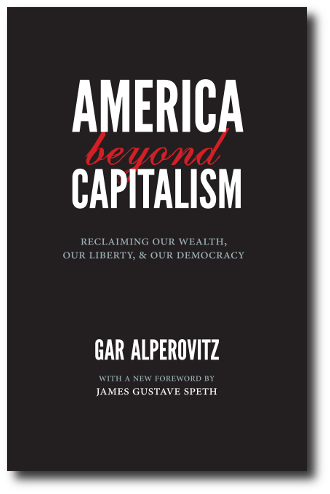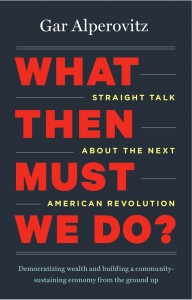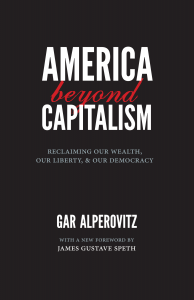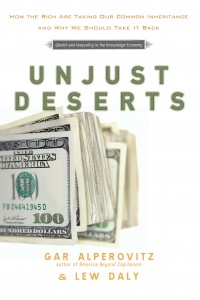This article, adapted from the introduction to the new edition of my book America Beyond Capitalism, first appeared in the November/December edition of Dollars & Sense.
 “Black Monday,” September 19, 1977, was the day 34 years ago when the shuttering of the Youngstown Sheet and Tube steel mill threw 5,000 steelworkers onto the streets of their decaying Midwestern hometown. No local, state or federal programs offered significant help. Steelworkers called training programs “funeral insurance”: they led nowhere since there were no other jobs available. Inspired by a young steelworker, an ecumenical religious coalition put forward a plan for community-worker ownership of the giant mill. The plan captured widespread media attention, the support of numerous Democrats and Republicans (including the conservative governor of the state at the time), and an initial $200 million in loan guarantees from the Carter administration.
“Black Monday,” September 19, 1977, was the day 34 years ago when the shuttering of the Youngstown Sheet and Tube steel mill threw 5,000 steelworkers onto the streets of their decaying Midwestern hometown. No local, state or federal programs offered significant help. Steelworkers called training programs “funeral insurance”: they led nowhere since there were no other jobs available. Inspired by a young steelworker, an ecumenical religious coalition put forward a plan for community-worker ownership of the giant mill. The plan captured widespread media attention, the support of numerous Democrats and Republicans (including the conservative governor of the state at the time), and an initial $200 million in loan guarantees from the Carter administration.
Corporate and other political maneuvering in the end undercut the Youngstown initiative. Nonetheless, the effort had ongoing impact, especially in Ohio, where the idea of worker-ownership became widespread in significant part as the result of publicity and educational efforts traceable to the Youngstown effort—and because of the depth of policy failures and the continuing pain of deindustrialization throughout the state. In the more than three decades since that effott, numerous employee-owned companies—inspired directly and indirectly by the effort to save the Youngstown mill—have been developed in Ohio. Individual lives were also changed, among them that of the late John Logue, a professor at Kent State University who established the Ohio Employee Ownership Center, an organization that provides technical and other assistance to help firms across the state become worker-owned.
There has also been an evolution in the position of the United Steelworkers union. In the late 1970s the union saw worker-ownership as a threat to organizing, and it opposed efforts by local steelworkers to explore employee-owned institution-building in cities like Youngstown. Over the decades, however, the union changed its position as its leaders saw the need to supplement traditional forms of labor organizing with other strategies. The union has now become a strong advocate of worker ownership, and is actively working to develop new models based upon the Mondragón Cooperative Corporation in the Basque country of Spain. This highly successful grouping of worker-owned cooperatives employs 85,000 people in fields ranging from sophisticated medical technology and the production of appliances to large supermarkets and a credit union with over 21 billion euros in assets.
The developmental trajectory from Youngstown to today illustrates what might be called “forced institutional innovation”—a process that, once underway, also suggests further possibilities for larger-scale and more refined development both within Ohio and elsewhere—especially as many other parts of the nation now experience the massive job losses and community decay that hit Ohio and other rustbelt states three decades ago. Critically, all involve new ways to give concrete meaning to the idea of democratizing capital.
§§§
One line of this development points towards increasing knowledge, along with local innovation and the buildup of new and ever more sophisticated strategies over time. The most recent and advanced of these is a major effort in Cleveland that has taken the idea of worker-ownership forward in new ways. The “Cleveland Model” now underway in that city involves an integrated complex of worker-owned cooperative enterprises targeted in significant part at the $3 billion purchasing power of such large scale “anchor institutions” as the Cleveland Clinic, University Hospital, and Case Western Reserve University. The complex also includes a revolving fund so that profits made by the businesses help establish new ventures as time goes on. (Full disclosure: I was one of the chief planners of the Youngstown steel effort, and The Democracy Collaborative, an organization which I co-founded, played a major role in helping develop the Cleveland effort.)
The first of the linked worker-owned companies, Evergreen Cooperative Laundry, is a state-of-the-art commercial laundry that provides clean linens for area hospitals, nursing homes, and hotels. The thoroughly “green” company operates out of a building that received a LEED (Leadership in Energy and Environmental Design) “Silver” rating for its energy-saving design and uses (and only has to heat) less than one third as much water per pound of laundry as typical competitors. At full staff it will include 50 worker-owners. The enterprise pays above-market wages, provides health insurance, and is still able to compete successfully against other commercial laundries. Another company, Ohio Cooperative Solar (OCS), provides weatherization services and installs, owns, and maintains solar panels on the rooftops of large university, hospital, and civic buildings. In its first year of operations OCS installed 400 kilowatts of solar generation capacity and is on target to more than double Ohio’s current total statewide solar generating capacity of two megawatts by 2012.
A commercial hydroponic greenhouse that covers 3.25 acres and will be capable of producing three million heads of lettuce a year broke ground on October 17 of this year. Additional new worker-owned businesses are being developed at a planned expansion rate of two to four ventures per year. A twenty-acre land trust will ultimately own the land upon which many of the businesses are situated and will serve as a first step to facilitating development in targeted neighborhoods of urban agriculture, and, when conditions permit, affordable housing. Like the Steelworkers, the Cleveland group has also drawn upon the experience of the Mondragón cooperative model, particularly in the design of its revolving fund.
Although the model began as a foundation- supported effort, the trajectory of institution-building development also has clear political implications. The Cleveland worker-owned businesses, backed by the city’s mayor, shrewdly utilized many of the same municipal, state, and federal tax, loan and other incentives available to any business. In turn, the success of the effort has also bolstered political support for the city’s liberal mayor. It also has slowly begun to suggest ways to make city officials less vulnerable to demands by major corporations seeking huge tax and other inducements to locate, often temporarily, in the city. Put another way, the developing institutional form has suggested the outlines of a new power constellation that in effect slowly displaces corporate influence, a strategy that may one day take its place alongside more traditional “countervailing-power” strategies that attempt to regulate, tax, and “incentivize” corporate power. In a further development, the Cleveland model has become the basis for new national legislation about to be introduced by Sen. Sherrod Brown to provide federal support to test the approach in other cities.
The effort has also struck a chord among activists and economic development practitioners throughout the nation who are concerned with the collapse of the economic core of many cities. Exploratory efforts are currently underway to replicate aspects of the Cleveland model in Atlanta, Pittsburgh, Washington, D.C., and several other communities. The “demonstration effect” of the highly unorthodox model has also begun to challenge community organizers to find ways to incorporate worker-owned development into grassroots activist strategies.
§§§
The long evolutionary trajectory traced by developments in Ohio offers lessons worth careful examination by activists and scholars alike. First, experience in Cleveland and in many cities now exploring replication of the model demonstrates that worker-owned co-ops are well within American political possibilities. Local businessmen, bankers, and others, in fact, commonly support the idea both on practical and moral grounds. To the extent such efforts increase local economic activity they help the local economy. Moreover, the focus on work and even ownership is seen by all parties as a positive contribution. The atmosphere at the local level is far different from the ideologically driven national political debate: What counts above all is whether the projects are intelligently developed, practical, and serious. In the midst of the worst financial crisis in modern history, the Cleveland worker-owned co-ops were able to secure bank financing for key projects. The idea of creating wealth, not simply jobs, also has a powerful resonance. The Evergreen model takes us well past token job creation at minimum wages in states like Rick Perry’s Texas, to a very different conception of what people deserve and ought to be able to have.
Institution-changing projects like the Cleveland model also demonstrably have the power to alter ideas about what can be talked about in conventional discourse—particularly ideas about who should own “the means of production.” The developmental path, importantly, is an example of the historical creation of political knowledge: To use a concept put forward by Italian theorist Antonio Gramsci, the practical, the very down-home efforts challenge the dominant, hegemonic ideology in a very unorthodox American way. They introduce a new idea into common culture. Another question they pose is how, in practical terms, serious activists committed to the long haul might aim in this and other ways to self-consciously shift what can be discussed in politics over time. One obvious line of development that might flow from the Ohio experience would be a concerted and self-conscious effort to attempt to create more worker-owned businesses, backed by local political support, wherever possible. The nation’s ongoing and likely continued economic stagnation and decay appear all but certain to create conditions in many American communities similar to those that gave rise to the Youngstown effort, the follow-on developmental path in Ohio, and the Cleveland model.
A mere one percent at the top now owns roughly half of the nation’s investment capital—more wealth than the entire bottom half of society taken together. This is literally a medieval pattern of ownership. Worker co-ops are one way to offer a practical alternative to this pattern, but they are not the only way. There are many other ways to democratize ownership—to move ownership out of the corporate system and in one way or another to institutions that are community-serving. This is far less familiar ground for most activists and scholars. Nonetheless, at the community level where the pain has been greatest, many other ways to democratize ownership have been quietly developing over the last several decades. All in one way or another give practical meaning to the simple idea that wealth and ownership ought rightly to be lodged in institutions that serve the community or broader social purposes.
Just below the surface of media attention, for instance, there are more than 4,500 not-for-profit community development corporations that operate affordable housing and other community-building programs in cities throughout the United States. In many cities new “community land trusts,” once viewed as beyond the pale, now increasingly use nonprofit or municipal ownership to develop and maintain permanently affordable housing. “Social enterprises” that run businesses to support such community-serving missions as drug rehabilitation and training programs comprise an emerging “fourth sector” of the economy (different from the government, business, and non-profit sectors). Another 130 million Americans are members of urban food and housing co-ops, traditional agricultural cooperatives and, importantly, widespread credit unions. Additionally, approximately 1.5 million non-profits provide more than 10% of the nation’s employment.
It is also important to begin to take seriously the 11,000 other businesses that are owned in whole or part by their employees. More than 13 million individuals are involved, several million more than are members of private-sector unions. Though Employee Stock Ownership Programs (ESOPs) have often been the subject of well-deserved criticism, many are now experimenting with increasingly participatory strategies aimed at overcoming past difficulties. Some are both worker owned and unionized, suggesting further longer-term evolutionary possibilities in connection with this ownership model. In Ohio, moreover, preliminary research indicates that as the share of ownership increases over time, so too does participation. Other studies show that greater participation brings greater profit—another longer-term dynamic favoring change in this sector. At some point a serious effort to radically reform the ESOP model and build upon its long developmental trend might well converge politically with other democratizing efforts. Critically, even in compromised form, the various enterprises all demonstrate the political viability and importance of the principle that workers can and should own capital.
Virtually all the democratized ownership forms—including thousands of co-ops, land trusts, social enterprises, and worker-owned companies of one kind or another—are also characterized by another principle of political importance, especially as ongoing economic decay destabilizes city after city: All are inherently anchored in, and supportive of, the local economy. Unlike private corporations, worker-owned companies of all descriptions rarely move to another city. The fate of those who own the company is intimately tied to the fate and health of the locality in which they both live and work. Virtually all the many other non-profit and related institutions based on democratized ownership principles are similarly place-anchored.
§§§
It is instructive to underscore the “situational logic” that is both allowing and helping generate long-term innovation and institution-building of this kind—and its relationship to possible new directions for progressive politics. The driving force is the ongoing failure of traditional policy—and a deepening awareness that traditional efforts have reached a dead end.
A careful review of developments in connection with health care and finance also suggests emerging democratizing possibilities in other areas as well—again, especially as pain levels increase, and again when understood not simply in terms of immediate politics, but in terms of longer evolutionary trajectories of committed development. Even as the Obama health-care reform law has come under intense attack—and indeed, in significant part because of this—more than fifteen states are exploring one or another form of single-payer health care. Another fourteen states are considering creating state banks, following the long-established North Dakota model, a trend that is also likely to intensify when further Wall Street financial crises again have an impact on Main Street. Other well established public forms might also potentially be built upon—including state pension fund investing for public purposes (as in California and in Alabama where a somewhat maverick public strategy has long invested even in worker-owned firms). The well-known case of the Alaska Permanent Fund is also of interest as a model that translates public ownership of assets into direct citizen financial benefits. Many states, moreover, now commonly invest in new companies through venture capital strategies, keeping significant shares under public ownership—an approach that in future could open the way to other, more expansive public possibilities.
Central to these various developments is the question of perspective: Many of the possibilities in one way or another have begun to take shape and move in a new direction, again, because as in Ohio traditional progressive reform strategies are no longer capable of providing solutions to ever more painful problems. Confronting—and taking advantage of—this paradoxical dynamic presents challenges to both traditional and radical understandings. The “evolutionary reconstructive” strategic approach they illustrate is a form of change different not only from traditional reform, but different, too, from traditional theories of “revolution.” The various efforts all also involve a sense of the importance of a long, evolutionary process that builds towards institutions (and ideas) that may offer ongoing ways to fundamentally alter economic and political relationships over time.
At this stage of development the central strategic questions are how to refine and expand various models—and how over time to legitimate the idea of democratized ownership in general. Ultimately, however, such strategies must converge with (and provide new content for) political mobilizations, movement-building and electoral efforts that take us beyond liberal and populist categories of change. As in the prehistory of the Progressive Era—when what subsequently became elements of the New Deal were first developed in state and local “laboratories”—it is also possible that the quietly emerging mosaic of experience and ideas could establish principles that might be applied to larger scale structures when a new progressive politics once again arises out of the pain. The U.S. government did, after all, nationalize two auto giants, G.M. and Chrysler, in the recent crisis for a substantial period. Given the huge financial flows it directed to major banks and other financial institutions, it also could well have established public control of one or more of these as well. Such possibilities are likely to return in future. Far-reaching change of this kind, and beyond, might one day be achieved if serious scholars and activist are able to build forward on the emerging developments to create even more advanced democratizing models—along with constituencies that have come to understand why they are important to a democratic future.
GAR ALPEROVITZ, Lionel R. Bauman Professor of Political Economy at the University of Maryland and co-founder of the Democracy Collaborative, is the author of America Beyond Capitalism: Reclaiming Our Wealth, Our Liberty and Our Democracy, a new paperback edition of which will be published this month by The Democracy Collaborative and Dollars & Sense. He is working on a new book on long-term institutional and systemic change.
 AMERICA BEYOND CAPITALISM
AMERICA BEYOND CAPITALISM



 Agenda
Agenda  Posterboard
Posterboard 